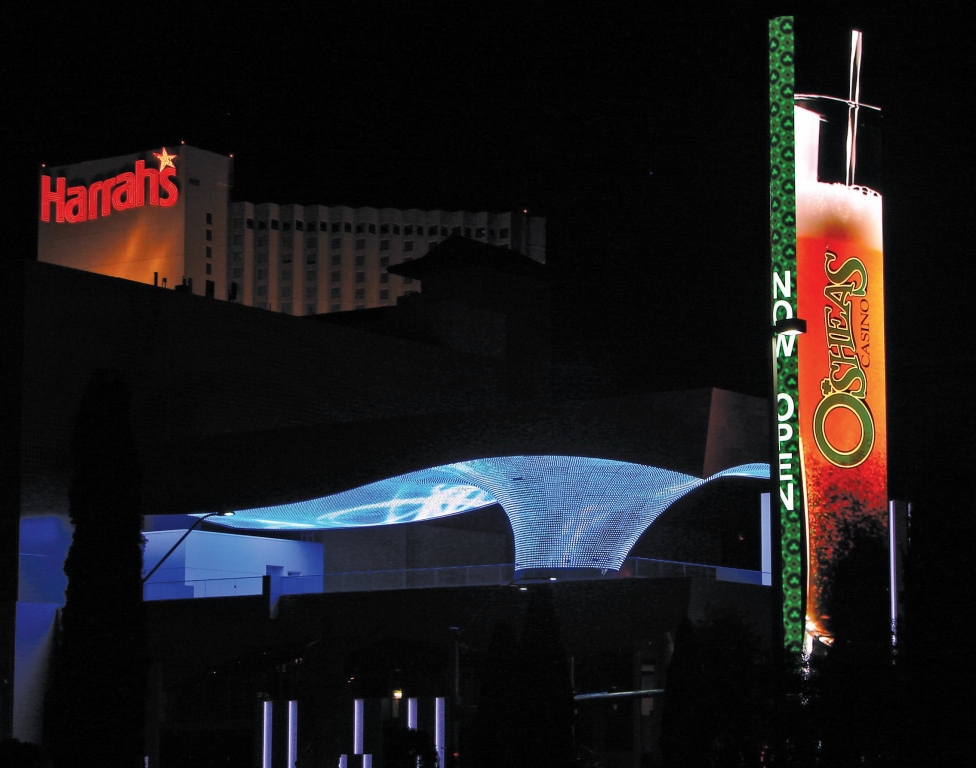Design
The Linq’s Many Faces
LED and LCD displays complement neon spectaculars to creative immersive experience.
Published
9 years agoon

Louis M. Brill is a journalist and consultant for high-tech entertainment and media communications. He can be reached at (415) 664-0694 or louismbrill@gmail.com.
The Linq (pronounced “link”) is a new, mixed-use, retail/dining/entertainment, outdoor promenade in Las Vegas. It connects its guests to as much outdoor fun as they can stand, including multi-flavored daiquiris, gourmet hot dogs, block parties with lots of dancing, musical entertainment at a bowling alley, and dynamic-digital signs (DS) that can create “selfies” and send them anywhere in the world. It’s also the home of the world’s largest (550-ft. diameter) observation wheel.
Recently completed, the Linq is located between the Linq Hotel and Casino, formerly the Quad, and the Flamingo hotels. Owned and operated by Caesar’s Entertainment, the Linq uniquely stands perpendicular to Las Vegas Blvd. (The Strip) and runs across the entire block to Paradise Dr. It presents a “Main Street,” commercially zoned, district with brick walkways, street lamps, surrounding foliage and abundant signage.
The entire walkway comprises 300,000 sq. ft., with approximately 30 retailers, and a tenant mix (70% restaurants and bars and 30% retail and entertainment) that offers Sprinkles Cupcakes (which includes a 24-hour, cupcake ATM), Purple Zebra (guests can self-serve 20 flavors of frozen daiquiris), Polaroid Fotobar (a nostalgic visit to instant, hard-copy prints), O’Shea’s (beloved Irish bar and casino with its 60 beer choices and live entertainment), Brooklyn Bowl (part bowling alley with 32 lanes, part concert hall and part restaurant) and the Haute Doggery (gourmet hot-dog restaurant). As one Linq enthusiast said, “You can start your day at the Linq, or end your evening there.”
A Las Vegas, outdoor, pedestrian mall is unique, because all previous hotel/casino malls featured enclosed interior spaces embedded within their properties. Here, the Linq competes with pre-existing, pedestrian Strip traffic destined elsewhere. Every year, at least 20 million people walk past the Linq. The challenge? Getting foot traffic into the Linq. The solution? Vibrant signage.
AdvertisementThe Linq’s layered sign program includes its entrance signage, an illuminated media façade and LED pylon. Once inside, visitors see a steady progression of tenant signage, intermingled with interactive touch screens, both of which allow visitors to easily navigate throughout the Linq.
Linq pylon
The majority of Linq signage was designed, fabricated and installed by Young Electric Sign Co’s. (YESCO) Las Vegas facility. The Linq is surrounded by neighboring hotels, and thus “hidden” from The Strip. It establishes an immediate presence with two gateway displays, its LED pylon and its companion monument, The Vortex (opposite the pylon), an enigmatic, illuminated “lighthouse” rooftop structure that offers a 24/7 lightshow directly in front of the Linq.
The Linq’s pylon is unique, as described by former YESCO senior design associate Brian Henry, who now operates his own, multi-disciplinary, eponymous design firm. His firm provides DS content and show control, which ranges from monument LED signs to the more diminutive, LCD-screen retail networks. Henry co-designed the Linq’s pylon and designed/implemented the control system that delivers its messaging content (first at YESCO and now as an independent design firm). Henry also provided the Vortex’s original lighting schemes, plus ongoing new material for its media façade, a companion gateway spectacle for The Linq.
The Linq’s wedge-shaped, three-sided, LED screen pylon, a 130-ft. digital totem (co-designed by Henry and Jim Gietzen), serves as an ongoing calling card of tenant activities. To manage the pylon’s content, Henry noted design and placement challenges, which include its streetside location, a
screen design of two separate LED displays, and an upper, monumental LED display with its long-distance viewing screen visible to both vehicular and pedestrian traffic. A smaller LED screen solicits street-level, pedestrian engagement.
Because the pylon’s location offers a very narrow observational point of view (POV) on The Strip for oncoming, vehicular/pedestrian traffic, its left and right screen sides angle out toward Strip traffic to increase visibility. The third (back) side of the pylon faces inwards toward Linq guests strolling within its promenade corridor. The dominant Linq pylon screens include two front-wedged, 110-ft.-tall x 20-ft.-wide displays. The third screen is also 110 ft. tall, but narrower at 15 ft. wide. These three screens present a 16mm, surface-mount-diode (SMD) pitch (2,016 x 1,088-pixel matrix) and messages easily seen by vehicles that approach the pylons or by Linq guests in back of it.
Below the main LED displays, a series of smaller LED screens configured at pedestrian level draws passersby onto the promenade. The 12-ft.-tall x 16-ft.-high LED screen also wraps around the pylon’s three sides. The smaller screens are rated at a 10mm SMD, with a 352 x 1,088-pixel matrix.
Henry said the messaging is divided between the two LED screen formats: “Because of the scale difference between the Linq pylon’s upper and lower LED screens, they serve two separate viewing audiences. The upper screen is directed towards vehicular traffic and pedestrians approaching The Linq from several blocks away.
Because drivers make up most of the pylon’s viewing audience, the pylon’s displays are designed to create more of an ‘at-a-glance’ message. It’s a simple presentation of a solid background color, an entertainment-related icon [a dancer or a drink silhouette] and one or two words, all designed to leave an inspirational impression in the few seconds the driver approaches and passes the pylon.”
The lower pylon screen, with its high-resolution, 10mm SMD display, is solely for pedestrian viewing. This offers a longer dwell time and allows for more text to alert passersby to all the fun at the Linq – just steps way.
Vortex lighthouse beacon
Directly opposite the Linq pylon is the Vortex, which overlooks the Linq’s entrance and sits atop its casino rooftop. The Vortex acts as a futuristic lighthouse whose structural shape is an eye-catching, cantilevered canopy that vaguely resembles Aladdin’s lamp or a woman’s high-heel shoe. The canopy’s sensuous curves are completely covered in LEDs. With its lighting and structurally sculptured look, it draws the curious to watch its ongoing lightshows.
Fabrication, assembly and its LED application were all handled by YESCO’s Las Vegas division. Once the Vortex steel structure was in place, placement of its street-side lighting system began with a series of LED-based, custom-shaped tiles that became the building’s façade. LED placement was determined by a proprietary YESCO puck configuration (a circular module with an RGB LED set embedded within the puck). Individually addressable, the 55 pucks are designed on a single string, all serially wired together. Each façade tile was drilled with a series of holes to indicate puck placements. Each puck string was fitted onto its appropriate tile and, one by one, the puck panels were fitted together, placed across the entire Vortex structure and then carefully wired to each other.
The Vortex’s 24/7 lightshows offer a constant draw to the Linq entrance. Henry, who developed the original lighting schemes for the Vortex while at YESCO, continually adds to the lightshow library. “The basic illumination of the Vortex is like a ‘liquid pour,’ where the lightshow starts at the bottom of its rooftop stem, pushes upwards towards the canopy, flows to the end, and then repeats. Another phase of its lighting design is a series of themed lightshows based on specific holidays: a patriotic show for Memorial Day and 4th of July [red, white and blue stars and stripes], a St. Patrick’s Day [green with four-leaf clovers] show and other seasonal events.”
Interactive digital kiosks
As visitors enter the Linq, they immediately encounter custom-designed, YESCO, outdoor, interactive LCD display kiosks. The kiosks present two LCD screens embedded within a freestanding, 10-ft.-tall x 45-in.-wide, finished-aluminum case (rated at IP 65). The screens provide 1,920 x 1,080-pixel resolution and a brightness level of 2,000 nits.
YESCO product director and account executive Nick Lee said the kiosk’s unique features include a camera for social-media connectivity, a credit-card reader for onsite purchases of show tickets, and a speaker system. The configuration features dual LCD displays. The upper, smaller screen is a dedicated advertising display that alerts Linq visitors to onsite tenant services and related entertainment activities.
The lower, larger, touch-sensitive LCD screen connects visitors to the Linq as a “digital concierge” in several engaging ways:
• Wayfinding identifies Linq tenant locations in relation to dining, shopping and entertainment opportunities.
• Advertising of additional Linq and Las Vegas entertainment activities
• Social-media connections enable kiosk users to create a “selfie” (a self portrait) of them at the Linq, and to e-mail that picture to family and friends for Facebook/Flickr postings.
Beyond interactive digital signage, social media is becoming critical in people’s connectivity between a brand, their contact with the brand, and their opportunity to share that experience via Twitter, e-mail or, in this case, digital signage. “As digital signage expands in the marketplace,” said Lee, “we think social media will continue to be part of how people keep in touch in the public space, and that digital signage will continue to play a part in that social connectivity.”
In the final operation, its LCD network will operate with nine interactive kiosks deployed around the promenade. Kiosk units are also installed within the Flamingo and Linq hotels, which allows those guests to review Linq promenade opportunities, and then walk outside and enjoy them.
The Linq sign look
In competing with The Strip and other outdoor destinations, the Linq’s tenant signage strives to be more exciting and eye-catching, with each sign designed to attract its share of visitors. For starters, Jim Gietzen, YESCO’s design director who supervised the overall collection of YESCO’s Linq signage, notes “the Linq is definitely a different outdoor vibe and, in making it attractive to passing visitors, YESCO started by designing many of the outdoor signs to be a little more oversized, to make them more expressive and appealing.”
The Linq’s eclectic collection of tenants created a mix of sign styles ranging from a vintage 1930s theatre marquee to more contemporary-looking, avant-garde displays.
In some cases, tenants had a pre-determined sign style. In other cases, tenants were open to a more individually stylized look, and such collaboration occurred between the tenant, the architect (Klai Juba Wald, Las Vegas, NV) and YESCO.
Gietzen said, “Some of the first things we take into account are the available square-footage areas we have to work with, the POV sightlines for each of these signs, and where the sign is going to be installed, all important factors to the design process. There is also the consideration of who the client is and what kind of an image they are trying to project. All that individually gave us lots of creative opportunities to develop each tenant’s unique signage identity. As for lighting, we used LEDs, lamps and neon in various combinations to give us the best-looking signs possible.”
Limited space prevents us from discussing every sign, so we start with one of the biggest and most prominent, The Brooklyn Bowl, whose vintage look is explained by Gietzen. The tenant wanted to evolve its brand and settled on a 1930s-style, movie-palace marquee. “To get a proper design for this front-of-building sign, I went through a library of photos of different 1930s movie-palace marquees from New York and Chicago. I then picked out various marquee pieces and parts as design elements and combined them all together for the Brooklyn Bowl’s final look, which turned out to be an old, bull-nose marquee with lots of lamps and animation.
“To get that ‘aged’ look, we created an old vintage sign that appeared taken from a junkyard, and restored it with other pieces and parts of similar marquee signs. Although we gave the Broadway Bowl sign a very distressed look, it was all custom-built as a new sign, combining a marquee with an attraction board and an attached vertical blade sign. The overall marquee was symmetric; both sides feature state-of-the-art LED lighting and neon illumination.”
In contrast to the Brooklyn Bowl, The Purple Zebra (after a couple of their daiquiris, you just might see one), with its buffet of different daiquiris, Gietzen said, “was all about its multiple flavors and colors, which translated into a sign of glass and chrome based on the style of the Route 66 era. Although the sign has a retro look, we used LEDs and neon for all the fill lighting. In effect, this allowed us to combine an out-of-date look with modern lighting to give the tenant a retro-meets-techno presence.”
Going in circles
Another Linq sign should be briefly highlighted, because it has no words or pictures, can be seen anywhere around Las Vegas, and has an impressive height and shape. Oh, and it just happens to be 550 ft. tall. It’s a sign, more iconically, because its shape connotes both a message and attracts people. We refer to the High Roller, which is the largest observation (Ferris) wheel in the world.
Nestled at the back of the Linq, facing Paradise Dr., the High Roller has 28, 40-person gondolas and, at capacity, has 1,120 people going round in circles as they leisurely (one rotation is 30 minutes) observe the surrounding Las Vegas cityscape. The High Roller is best ridden at night, when all Las Vegas signage is lit up, and its full splendor can be seen glowing in total brightness with promises of what could happen in Las Vegas, and the signs will never tell….

SPONSORED VIDEO
Introducing the Sign Industry Podcast
The Sign Industry Podcast is a platform for every sign person out there — from the old-timers who bent neon and hand-lettered boats to those venturing into new technologies — we want to get their stories out for everyone to hear. Come join us and listen to stories, learn tricks or techniques, and get insights of what’s to come. We are the world’s second oldest profession. The folks who started the world’s oldest profession needed a sign.
You may like
Advertisement
Subscribe

Magazine
Get the most important news
and business ideas from Signsofthetimes Magazine.
Advertisement
Most Popular
-

 Business Management1 week ago
Business Management1 week agoWhen Should Sign Companies Hire Salespeople or Fire Customers?
-

 Women in Signs1 week ago
Women in Signs1 week ago2024 Women in Signs Award Winners Excel in Diverse Roles
-

 True Tales2 weeks ago
True Tales2 weeks agoSign Company Asked to Train Outside Installers
-

 News2 weeks ago
News2 weeks agoAvery Dennison Wrap Like Royalty Challenge Now Open
-

 Editor's Note5 days ago
Editor's Note5 days agoWhy We Still Need the Women in Signs Award
-

 Maggie Harlow2 weeks ago
Maggie Harlow2 weeks agoThe Surprising Value Complaints Bring to Your Sign Company
-

 Line Time1 week ago
Line Time1 week agoOne Less Thing to Do for Sign Customers
-

 Product Buying + Technology6 days ago
Product Buying + Technology6 days agoADA Signs and More Uses for Engraving Machines









